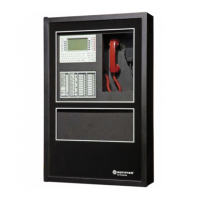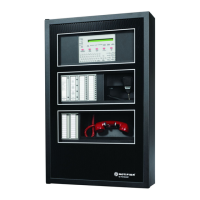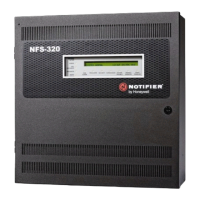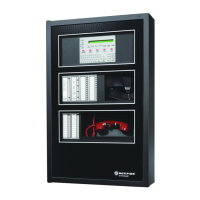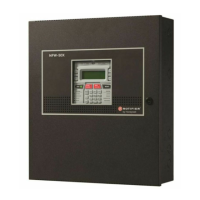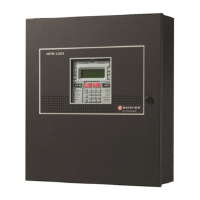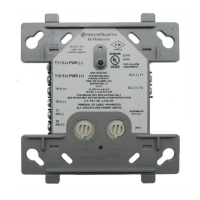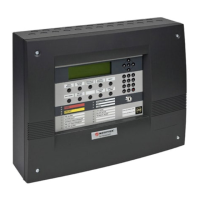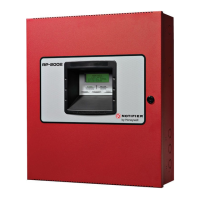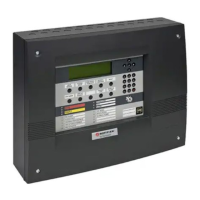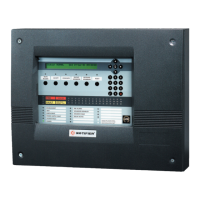NFS2-3030 Programming Manual — P/N 52545:K1 03/20/2012 153
Glossary
0.1 Glossary
This section contains descriptions of terms essential to
know when programming the control panel.
Alarm History See History buffer.
Alarm Verification Timer A user-defined global
software
timer function that can reduce the number of
nuisance alarms. When you select Alarm Verification
for a detector, the control panel delays an alarm signal
for a user-specified time period. (The control panel
ignores the Alarm Verification Timer if it detects
another alarm during the verification period.)
Argument An argument is a discrete part of a logic
fu
nctio
n used in a CBE logic or trouble equation. It can
consist of panel/SLC addresses for detectors, modules,
zones, special function zones, logic or trouble equations.
Auto Silence Timer A user-defined global software
timer th
at functions like pressing the signal silence key.
The control panel silences all active outputs
programmed as silenceable once the timer has reached
the selected time. For example, if 20 minutes is selected,
when the timer reaches 20 minutes the control panel
turns off all active outputs programmed as silenceable.
Autoprogram A software routine that directs the
cont
rol
panel to identify and automatically load SLC-
connected devices into the program with default values
for all parameters. The Autoprogram Finds and displays
all new or missing intelligent detectors and modules--
while ignoring devices already installed in memory--so
you can edit default option selections. Typically, you
Autoprogram the control panel as a first step in a new
installation, or to add devices.
Control module An addressable module that a)
switch
e
s power to a Style Y or Style Z NAC; or b)
functions as a Form-C control relay.
CBE (Control-by-Event) A
programming method that
lets you map inputs and outputs to provide a variety of
output responses based on various initiating conditions
(events).
CLIP poll - Classic
Loop Interface Protocol - CLIP - is
standard polling of each intelligent device (as
differentiated from FlashScan poll, a method of group
polling described below).
DCC (Display and Control Center) - Te
rm for a
display location, programmed to participate in DCC,
when it has control of Acknowledge, Signal Silence,
System Reset and Drill functions.
Drift Compensation An algorithm which permits the
ma
intenance of a constant smoke detector sensitivity by
accounting for environmental contaminants and other
factors.
Download A function for loading a system program
from
a file on a personal computer and storing the
program in system memory of the control panel. Also
see Veri•Fire.
FlashScan poll - a patented system (US Patent Number
5,539
,389) that enhances the speed of communication
between analog intelligent devices. Communication is
in a grouped fashion. When one of the devices within
the group has new information, the panel CPU stops the
group poll and concentrates on single points.
History buffer The control panel maintains a history
buf
f
er of the last 4000 events, each with a time and date
stamp. History events include all alarms, troubles,
operator actions, and programming entries. The control
panel also maintains a 1000-event Alarm History buffer,
which consists of the 1000 most recent alarm events
from the 4000-event history buffer.
latching An attribute of a device that keeps
it in an
active state until the condition causing the activation is
corrected and the panel is reset.
Missing device A device that exists in a program, but is
not fou
nd by the control panel during Autoprogram,
typically because the device is disconnected.
NAC (Notification Appliance Circuit) A circu
it or path
directly connected to a notification appliance device (a
fire alarm system component--such as a bell, speaker,
strobe, and so on--that produces an audible output, a
visual output, or both). On this panel, NACs can be
transponder points or control modules.
New device A device connected to the control panel,
bu
t not in
program memory.
Non-latching An attribute of a device that follows the
state of the
fire alarm system. That is, if a device is
non-latching, it returns to its normal state automatically
when the condition clears.
Notification Appliance Circuit see NAC.
Obscuration A reduction in the atmospheric
transparency caused by smo
ke, usually expressed in
percent per foot.
Output circuit A control module connected to the
SLC.
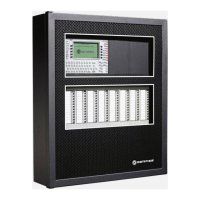
